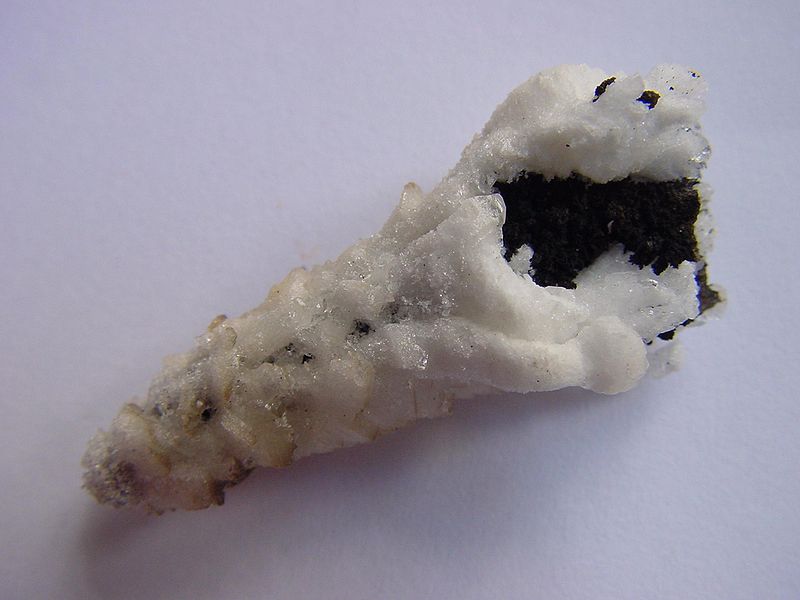The key to a hydrogen-based economy may come from an extremely simple mineral, which appears as a black spot on rocks

An international research team of scientists, led by researchers from Monash University in Australia, found that the key to a hydrogen-based economy may come from an extremely simple mineral, which appears as a black spot on rocks.
The research findings were published in the scientific journal Nature Chemistry. Professor Leone Spiccia from the School of Chemistry at Monash University in Australia explained that the goal of the researchers in this field is to develop a cheap and efficient way to split a water molecule, with the help of sunlight, into its basic components oxygen and hydrogen, a discovery that could lead to the production of hydrogen as a clean fuel and the development of long-term solutions to the energy crisis.
In order to achieve this goal, the researchers tested complex catalysts designed to mimic the catalysts that plants use to split water with the help of sunlight. However, the new research shows that there may be a much simpler alternative to this.
"The most challenging part of turning water into fuel is the splitting of water into oxygen and hydrogen, but it seems that the research team discovered the appropriate process, while developing a cell for splitting water containing a catalyst based on the metal manganese," explains the researcher.
"It turns out that the mineral Birnessite (The term in Wikipedia) is the key to this. Similar to other elements found in the center of the periodic table, manganese can exist in several oxidation states. When an electrical voltage is applied in the cell, the fission of water into hydrogen and oxygen occurs and when the researchers carefully examined the catalyst during its activity with the help of advanced spectroscopic methods, they found that it decomposes into a simpler substance known as Birnessite, well known to geologists as the black spot that appears on many rocks."
The manganese in the catalyst goes between two oxidation states. First, a voltage is applied which causes the oxidation of manganese from oxidation state II to oxidation state IV in the mineral. Then, when exposed to sunlight the mineral returns to the manganese-II oxidation state. This cyclical process is responsible for oxidizing water which results in obtaining oxygen gas, protons and electrons.
"This study may provide important insights into the evolution of the natural water-splitting catalyst found in all plants that use manganese metal for this purpose," notes one of the researchers. "Scientists have put a lot of effort into developing extremely complex manganese molecules to mimic the activity of plants, but it turns out that a common substance found on Earth is a material that is effective enough to perform this task."
The reaction involves two steps. First, two water molecules are oxidized to obtain one molecule of oxygen gas (O2), four positively charged hydrogen nuclei (protons) and four electrons. In the second step, the protons and electrons join together to form two molecules of hydrogen gas (H2).
The researchers hope that their findings will eventually lead to the development of cheap devices that produce clean hydrogen.

6 תגובות
It does not seem that transferring water would be a good way to transport hydrogen for energy needs, because breaking down the water and extracting the hydrogen from it would consume a greater amount of energy than what would be produced by "burning" the hydrogen.
Therefore it will always be more efficient to use the energy that we used to break down the water directly.
Someone else entirely:
Not necessarily, given a sufficiently similar energetic potential from hydrogen produced from a liter of water to a liter of fuel and a sufficiently small fission cell... the simplest way to transfer hydrogen would be... to transfer water
And the whole world is networked with so-called "pipelines" to transport water P:
Now regarding whether these potentials exist - I have no idea... I hope so... I'm sure Michael knows D:
The problems with the "hydrogen economy" are mainly the transportation and storage of
The hydrogen, which are completely uneconomical. As long as they don't solve the
These problems are that the use of hydrogen will always be too limited
Call it "economy" - and at most it will be used for accumulation
Energy in production stations based on renewable energy.
Haim,
In order to produce water in this way, you need hydrogen, the production of hydrogen today is too expensive for this process to be economic (or ecological) compared to water desalination.
In addition, hydrogen has the obnoxious property of exploding.
As for the fuel cells, this solution would be really elegant if they also managed to fix carbon in conjunction with this process (like the plants do).
It is equally possible to combine hydrogen and oxygen and get water. Why not do this to solve the water crisis in Israel and the world once and for all?
Beautiful and interesting, but also reminiscent of twenty-year-old studies that talk about a similar and close field. The player has been known and known for many years, the coupling with the light is also known... for the time being we do not see an economic vision on the horizon. I wish that in our lifetime we will get to understand the complex that causes the creation of oxygen in the chloroplast.